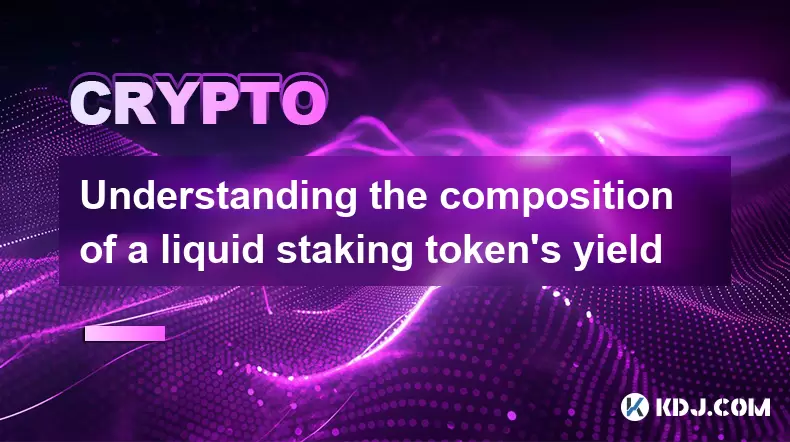-
 bitcoin
bitcoin $112195.049338 USD
2.42% -
 ethereum
ethereum $4124.915858 USD
2.81% -
 tether
tether $1.000570 USD
0.02% -
 xrp
xrp $2.861568 USD
2.25% -
 bnb
bnb $1000.346670 USD
3.04% -
 solana
solana $209.070819 USD
3.38% -
 usd-coin
usd-coin $0.999870 USD
0.02% -
 dogecoin
dogecoin $0.235379 USD
2.65% -
 tron
tron $0.335681 USD
-0.20% -
 cardano
cardano $0.803501 USD
3.38% -
 hyperliquid
hyperliquid $47.120881 USD
3.56% -
 chainlink
chainlink $21.501300 USD
3.44% -
 ethena-usde
ethena-usde $1.000571 USD
0.02% -
 avalanche
avalanche $29.793378 USD
3.62% -
 stellar
stellar $0.366964 USD
2.42%
Can you provide liquidity with liquid staking tokens?
Liquid staking tokens (LSTs) enable users to earn staking rewards while maintaining liquidity, as they can be traded or used in DeFi platforms like Uniswap and Curve for liquidity provision.
Jul 22, 2025 at 10:22 am

Understanding Liquid Staking Tokens
Liquid staking tokens (LSTs) are derivative tokens that represent staked assets on a proof-of-stake (PoS) blockchain. When users stake their native tokens (e.g., ETH, ATOM, SOL), they typically lock up their assets and lose liquidity during the staking period. To solve this issue, liquid staking protocols issue LSTs in exchange for the staked assets, allowing users to retain liquidity while earning staking rewards. These tokens can be traded, transferred, or used in decentralized finance (DeFi) applications.
Example: If you stake ETH on a platform like Lido or Rocket Pool, you receive stETH or rETH, respectively. These tokens are liquid and can be used elsewhere in DeFi, such as lending protocols or decentralized exchanges (DEXs).
How Liquidity Provision Works with LSTs
Providing liquidity with LSTs involves using these tokens in decentralized exchanges (DEXs) like Uniswap, SushiSwap, or Curve Finance. By depositing LSTs into a liquidity pool alongside another token (often the native token or stablecoin), users become liquidity providers (LPs) and earn trading fees.
Important Consideration: When you provide liquidity with LSTs, you expose yourself to impermanent loss (IL), especially if the value of the LST fluctuates relative to the paired asset. However, some platforms offer incentives or yield farming opportunities to offset this risk.
Steps to Provide Liquidity Using Liquid Staking Tokens
To participate in liquidity provision using LSTs, follow these steps:
- Choose a Compatible DEX: Ensure the DEX supports the LST you hold. For example, Uniswap supports stETH/ETH pools, while Curve supports stETH/ETH pools with specialized mechanisms.
- Approve Token Usage: Connect your wallet (e.g., MetaMask) and approve the DEX to interact with your LSTs.
- Deposit Liquidity: Select the pool you want to join and deposit your LST along with the paired token (e.g., stETH + ETH or stETH + DAI).
- Receive LP Tokens: After depositing, you’ll receive liquidity provider (LP) tokens representing your share of the pool.
- Earn Trading Fees: As trades occur in the pool, you’ll earn a portion of the fees based on your share of liquidity provided.
Note: Always check the slippage settings and gas fees before confirming the transaction. Some pools may require a rebalancing step if the assets have drifted in price.
Risks and Considerations When Using LSTs for Liquidity
While LSTs enable liquidity and yield opportunities, they also carry specific risks:
- Smart Contract Risk: The protocols issuing LSTs and managing liquidity pools are susceptible to vulnerabilities. Always assess the security audits and reputation of the platform.
- Impermanent Loss (IL): This occurs when the price of the assets in the liquidity pool changes compared to when you deposited them. IL can reduce or negate the gains from fee rewards.
- Volatility of LSTs: LSTs may trade at a discount or premium to the underlying staked asset, especially during market stress or when the protocol faces technical issues.
- Reward Variability: Yield from liquidity provision can fluctuate based on trading volume, pool size, and incentive programs.
Tip: Use tools like IL calculators and yield aggregators to estimate potential returns and risks before committing capital.
Real-World Examples of LSTs in DeFi Liquidity Pools
Several DeFi platforms have integrated LSTs to enhance liquidity and yield opportunities:
- Curve Finance: Offers stablecoin-LST pools (e.g., stETH/ETH) with low slippage and high capital efficiency.
- Balancer: Allows users to create or join pools with LSTs and other assets, offering customizable weightings.
- Yearn Finance: Integrates LSTs into vault strategies that aim to optimize yield through automated strategies.
- Aave and Compound: Accept certain LSTs as collateral, allowing users to borrow against their staked positions while still earning staking rewards.
Observation: LSTs are increasingly becoming a core component of DeFi infrastructure, enabling more efficient use of capital in a trustless environment.
Frequently Asked Questions (FAQs)
Q1: Can I unstake my tokens if I’m providing liquidity with LSTs?A1: Yes, you can withdraw your liquidity from the pool and redeem your LSTs for the underlying staked asset. However, the unstaking process may involve a waiting period or a penalty if the protocol has specific withdrawal conditions.
Q2: Are all LSTs compatible with every DEX?A2: No, compatibility depends on the DEX and its integration with the LST protocol. Always check whether the DEX supports the specific LST you are using before attempting to provide liquidity.
Q3: Do I continue to earn staking rewards while providing liquidity with LSTs?A3: Yes, one of the key advantages of LSTs is that they continue to accrue staking rewards even when used in liquidity pools. These rewards are reflected in the increasing value of the LST over time.
Q4: How do I track the performance of my liquidity position with LSTs?A4: You can use portfolio trackers like Zerion, DeFi Pulse, or Dune Analytics to monitor your liquidity positions, earned fees, and exposure to impermanent loss. Many DEXs also provide in-app dashboards for liquidity providers.
Disclaimer:info@kdj.com
The information provided is not trading advice. kdj.com does not assume any responsibility for any investments made based on the information provided in this article. Cryptocurrencies are highly volatile and it is highly recommended that you invest with caution after thorough research!
If you believe that the content used on this website infringes your copyright, please contact us immediately (info@kdj.com) and we will delete it promptly.
- PM Modi, RSS Centenary, and a Postage Stamp: A Curious Intersection
- 2025-09-29 18:45:12
- Ethereum ETF, Bitcoin ETF, and Investor Nerves: A New York Minute on Crypto
- 2025-09-29 18:25:14
- Ripple, Ondo Finance, and Tokenized Treasuries: A New Era for Institutional DeFi
- 2025-09-29 19:05:13
- Navigating the Crypto Seas: Federal Reserve, Bitcoin, and Interest Rate Tides
- 2025-09-29 18:25:14
- RSS Centenary: A Commemorative Coin and a Century of Impact
- 2025-09-29 18:45:12
- Avantis Crypto Price Crash Amidst Soaring Perpetual Volume: What's Going On?
- 2025-09-29 18:30:01
Related knowledge

Understanding the composition of a liquid staking token's yield
Jul 20,2025 at 09:07am
What Is a Liquid Staking Token?A liquid staking token is a representative asset issued to users who stake their native cryptocurrency on a proof-of-st...

Is it better to stake directly or use a liquid staking service?
Jul 22,2025 at 08:21pm
Understanding the Basics of StakingStaking in the context of blockchain and cryptocurrency refers to the process of locking up digital assets to suppo...

What to do during an LST depeg event
Jul 20,2025 at 04:57pm
Understanding LST Depeg EventsAn LST (Liquid Staking Token) depeg event occurs when the token, which is typically pegged to the value of the underlyin...

How to find new liquid staking projects
Jul 30,2025 at 01:14pm
Understanding Liquid Staking and Its ImportanceLiquid staking is a mechanism that allows users to stake their cryptocurrency assets while still mainta...

Can you provide liquidity with liquid staking tokens?
Jul 22,2025 at 10:22am
Understanding Liquid Staking TokensLiquid staking tokens (LSTs) are derivative tokens that represent staked assets on a proof-of-stake (PoS) blockchai...

What are the best wallets for storing LSTs?
Jul 21,2025 at 03:14pm
Understanding LSTs and the Need for Secure StorageLSTs, or Liquid Staking Tokens, are derivative tokens representing staked assets on a blockchain. Wh...

Understanding the composition of a liquid staking token's yield
Jul 20,2025 at 09:07am
What Is a Liquid Staking Token?A liquid staking token is a representative asset issued to users who stake their native cryptocurrency on a proof-of-st...

Is it better to stake directly or use a liquid staking service?
Jul 22,2025 at 08:21pm
Understanding the Basics of StakingStaking in the context of blockchain and cryptocurrency refers to the process of locking up digital assets to suppo...

What to do during an LST depeg event
Jul 20,2025 at 04:57pm
Understanding LST Depeg EventsAn LST (Liquid Staking Token) depeg event occurs when the token, which is typically pegged to the value of the underlyin...

How to find new liquid staking projects
Jul 30,2025 at 01:14pm
Understanding Liquid Staking and Its ImportanceLiquid staking is a mechanism that allows users to stake their cryptocurrency assets while still mainta...

Can you provide liquidity with liquid staking tokens?
Jul 22,2025 at 10:22am
Understanding Liquid Staking TokensLiquid staking tokens (LSTs) are derivative tokens that represent staked assets on a proof-of-stake (PoS) blockchai...

What are the best wallets for storing LSTs?
Jul 21,2025 at 03:14pm
Understanding LSTs and the Need for Secure StorageLSTs, or Liquid Staking Tokens, are derivative tokens representing staked assets on a blockchain. Wh...
See all articles










































































